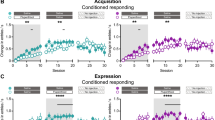Abstract
It has been shown that peripheral manipulation of sensory input by removal of vibrissae on one side of the rat's face induces turning behavior which is directed towards the contralateral vibrissae-intact side, under the influence of the dopamine receptor agonist apomorphine. In the present experiment, we examined whether rats under apomorphine turn towards the side with more sensory input, or simply away from the manipulated side. Thus, an experimental manipulation was designed to increase sensory input. Sensory stimulation was applied by attaching a clip into the fur on one side of the face. Rats injected with apomorphine in doses of 0.5–5.0 mg/kg (but not with 0.05 mg/kg or vehicle) exhibited turning behavior towards the side of the clip. This sensory stimulation was also found to influence spontaneous behavioral asymmetries. These results show that an imbalance in sensory input is sufficient to produce turning under apomorphine.
Similar content being viewed by others
References
Adams F, Schwarting RKW, Boix F, Huston JP (1991) Lateralized changes in behavior and striatal dopamine release following unilateral tactile stimulation of the perioral region: a microdialysis study. Brain Res 553:318–322
Beck CHM, Chow HL, Cooper SJ (1986) Dose-related response of male rats to apomorphine: snout contact in the open-field. Physiol Behav 37:819–825
Bonatz AE, Steiner H, Huston JP (1987) Video image analysis of behavior by microcomputer: categorization of turning and locomotion after 6-OHDA injection into the substantia nigra. J Neurosci Methods 22:13–26
Carli M, Evenden JL, Robbins TW (1985) Depletion of unilateral striatal dopamine impairs initiation of contralateral actions and not sensory attention. Nature 313:679–682
Carli M, Jones GH, Robbins TW (1989) Effects of unilateral dorsal and ventral striatal dopamine depletion on visual neglect in the rat: a neural and behavioural analysis. Neuroscience 29:309–327
Glick SD, Lyon RA, Hinds PA, Sowek C, Titeler M (1988) Correlated asymmetries in striatal D1 and D2 binding: relationship to apomorphine-induced rotation. Brain Res 455:43–48
Huston JP, Nef B, Papadopoulos G, Welzl H (1980) Activation and lateralization of sensorimotor field for perioral biting reflex by intranigral GABA agonist and by systemic apomorphine in the rat. Brain Res Bull 5:745–749
Huston JP, Steiner H, Weiler H-T, Morgan S, Schwarting RKW (1990) The basal ganglia-orofacial system: studies on neurobehavioral plasticity and sensory-motor tuning. Neurosci Biobehav Rev 14:433–446
Jerussi TP, Glick SD (1975) Apomorphine-induced rotation in normal rats and interaction with unilateral caudate lesions. Psychopharmacologia 40:329–334
Jerussi TP, Glick SD, Johnson CL (1977) Reciprocity of pre- and postsynaptic mechanisms involved in rotation as revealed by dopamine metabolism and adenylate cyclase stimulation. Brain Res 129:385–388
Keren O, Korczyn AD (1978) Asymmetry of turning behaviour in rats induced by amphetamine and apomorphine. Experientia 34:616
Ljungberg T, Ungerstedt U (1976) Sensory inattention produced by 6-hydroxydopamine-induced degeneration of ascending dopamine neurons in the brain. Exp Neurol 53:585–600
Marshall JF (1979) Somatosensory inattention after dopamine-depleting intracerebral 6-OHDA injections: spontaneous recovery and pharmacological control. Brain Res 177:311–324
Milani H, Schwarting RKW, Kumpf S, Steiner H, Huston JP (1990) Interaction between recovery from behavioral asymmetries induced by hemivibrissotomy in the rat and the effects of apomorphine and amphetamine. Behav Neurosci 104:470–476
Pisa M, Szechtman H (1985) Lateralizing effects of apomorphine on taxis, postural support and rotation in rats. Prog Neuropsychopharmacol Biol Psychiatry 9:525–531
Pycock CJ (1980) Turning behaviour in animals. Neuroscience 5:461–514
Rosner B (1986) Fundamentals of biostatistics. Duxbury, Boston
Schallert T, Upchurch M, Lobaugh N, Farrar SB, Spirduso WW, Gilliam P, Vaughn D, Wilcox RE (1982) Tactile extinction: distinguishing between sensorimotor and motor asymmetries in rats with unilateral nigrostriatal damage. Pharmacol Biochem Behav 16:455–462
Schwarting RKW, Steiner H, Huston JP (1990) Effects of hemivibrissotomy in the rat: time-dependent asymmetries in turning and biogenic amines induced by apomorphine. Pharmacol Biochem Behav 35:989–994
Schwarting RKW, Steiner H, Huston JP (1991) Asymmetries in thigmotactic scanning: evidence for a role of dopaminergic mechanisms. Psychopharmacology 103:19–27
Steiner H, Huston JP, Morgan S (1986) Apomorphine reverses direction of asymmetry in facial scanning after 10 days of unilateral vibrissae removal in rat: vibrissotomy-induced denervation supersensitivity? Behav Brain Res 22:283–287
Steiner H, Bonatz AE, Huston JP, Schwarting R (1988) Lateralized wall-facing versus turning as measures of behavioral asymmetries and recovery of function after injection of 6-hydroxydopamine into the substantia nigra. Exp Neurol 99:556–566
Szechtman H (1983) Peripheral sensory input directs apomorphine-induced circling in rats. Brain Res 264:332–335
Szechtman H, Ornstein K, Teitelbaum P, Golani I (1982) Snout contact fixation, climbing and gnawing during apomorphine stereotypy in rats from two substrains. Eur J Pharmacol 80:385–392
Szechtman H, Ornstein K, Teitelbaum P, Golani I (1985) The morphogenesis of stereotyped behavior induced by the dopamine receptor agonist apomorphine in the laboratory rat. Neuroscience 14:783–798
Ungerstedt U (1971) Striatal dopamine release after amphetamine or nerve degeneration revealed by rotational behaviour. Acta Physiol Scand Suppl 367:49–68
Welzl H, Flack HG, Huston JP (1982) Contraversive circling and facilitation of the perioral biting reflex by injection of substance P ord-Ala2-Met-enkephalinamide into the substantia nigra. Behav Neural Biol 34:104–108
Welzl H, Schwarting R, Kulajta J, Huston JP (1984) Perioral biting reflex and turning after intranigral injection of a GABA or metenkephalin agonist: role of the thalamus and superior colliculus. Exp Brain Res 55:438–444
Ziegler M, Szechtman H (1988) Differences in the behavioral profile of circling under amphetamine and apomorphine in rats with unilateral lesions of the substantia nigra. Behav Neurosci 102:276–288
Author information
Authors and Affiliations
Rights and permissions
About this article
Cite this article
Steiner, H., Huston, J.P. Control of turning behavior under apomorphine by sensory input from the face. Psychopharmacology 109, 390–394 (1992). https://doi.org/10.1007/BF02247713
Received:
Revised:
Issue Date:
DOI: https://doi.org/10.1007/BF02247713




